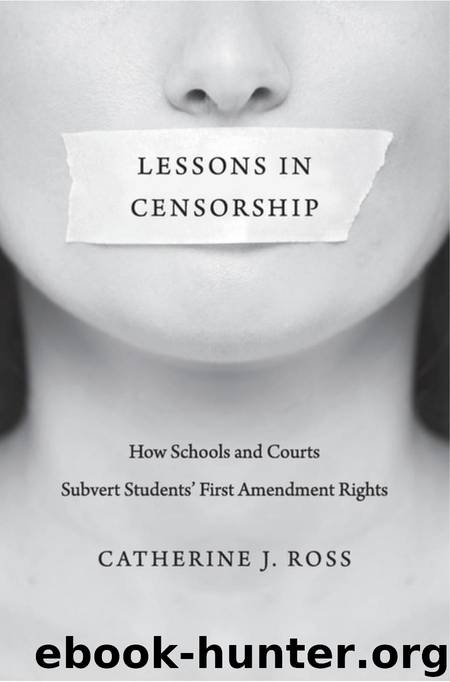Catherine J. Ross by unknow

Author:unknow
Language: zho
Format: mobi
Published: 2018-05-06T15:54:48+00:00
186 Tinker redux
much as proud Southerners, integrationists, and post- racialists. Whether they
intend to communicate hostility or believe they are only demonstrating pride
in their own culture, silenced students may be prone to conclude— as Barnette
warned— that authorities treat their freedom of speech as a “mere platitude.”
Recognition that the Speech Clause extends to racist expression or speech
that causes racial affront does not render educators powerless to react to
speech that offends many students and citizens. Schools can transform
offensive speech into teachable moments. In the real world children will
grow up to live in, they will likely have to learn how to respond to speech
they find objectionable and even unbearable without sinking to the offensive
speaker’s level or slugging him. It may be best to learn how to respond,
whether by walking away or questioning, as a student under the watchful
guidance of teachers rather than as an adult at a bar. Under the Speech
Clause, the best remedy for nasty speech is more and better- quality speech
that offers alternative visions and models civil responses.
“No . . . Hurt Feelings Defense”: Sensitivity, LGBT Students, and Politics
Targets for belittlement, and perceived belittlement, have proliferated in
recent decades, in direct response to mounting demands for recognition and
rights from a variety of groups. “Homosexuality is a sin,” declared the
T- shirt James Nixon purchased at a church meeting and wore to school.
“Islam is a lie!” the shirt continued. “Abortion is murder!” Nixon’s school
told him he could not wear the shirt because it might offend students and
staff members who were Muslims or homosexuals or had had abortions. The
school was wrong, as a federal court ruled in 2005.68
Since 2005 several federal appellate courts have invoked Tinker’s second
prong in analyzing the impact of disparagement on LGBT students. Almost
a third of states expressly barred disparagement based on sexual orientation
in schools as of 2012, and in April 2014 the federal government reinter-
preted the federal statute that bars gender discrimination as extending to
sexual orientation.69
Discussion of LGBT rights in the twenty- first century indisputably
involves political speech. Complaints against schools, however, suggest that
educators lie at two extremes: solicitous concern for the feelings of LGBT
students at the cost of free expression and assertions that schools lack any
legal duty to control harassment and violence aimed at LGBTs and may be
powerless to control similar conduct that falls short of harassment. All of
Words that harm 187
these concerns bring us back to the central question Justice Alito addressed
in Saxe: Does the Constitution permit a school to impose benignly moti-
vated limits on hurtful speech that does not meet the legal definition of
harassment or threaten material disruption?
In 2006, the Ninth Circuit looked to Tinker’s second prong in analyzing
whether a student had the right to wear a T- shirt that called homosexuality
“shameful.” The majority in Harper v. Poway Unified School District con-
cluded that students have a right to be protected from “cruel, inhuman, and
prejudiced treatment by others.” Verbal assaults based on “core identifying
characteristic[s],” the court found, “cause young people to question their
self- worth and rightful place in society.” Harassment “injure[s] and intim-
idate[s] them . . . and interfere[s] with their opportunity to learn.
Download
This site does not store any files on its server. We only index and link to content provided by other sites. Please contact the content providers to delete copyright contents if any and email us, we'll remove relevant links or contents immediately.
4 - Harry Potter and the Goblet of Fire by J.K. Rowling(2657)
2010-The City & the City by China Miéville(1945)
Wall and Piece by Banksy(1782)
Thank You for Being Late by Thomas L. Friedman(1739)
The Old Farmer's Almanac 2020 by Old Farmer’s Almanac(1661)
The Mirror and the Light by Hilary Mantel(1634)
Journey to the Abyss by Harry Kessler(1602)
The Andy Warhol Diaries by Andy Warhol(1565)
Tolkien, J. R. R. - The Fellowship of the Ring by Tolkien J. R. R(1497)
Life on Earth by David Attenborough(1434)
Art Nouveau by Carol Belanger Grafton(1398)
The Museum Of Innocence by Orhan Pamuk(1380)
Harry Potter - A History of Magic by British Library(1373)
The Business of Being an Artist by Daniel Grant(1339)
Frida by Hayden Herrera(1285)
The Future Is Japanese by(1272)
Impeach by Neal Katyal(1248)
A History of Japanese Art by Noritake Tsuda(1200)
1215 by Danny Danziger(1164)
